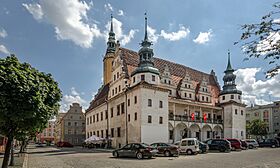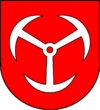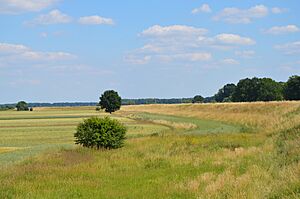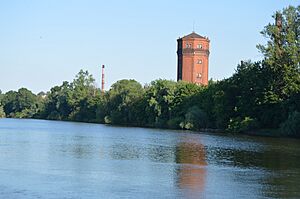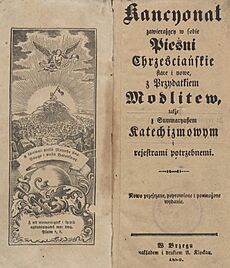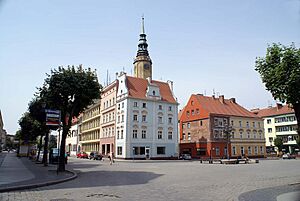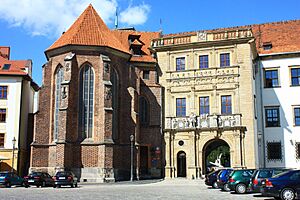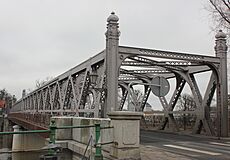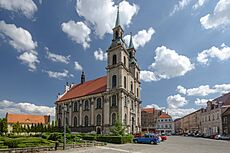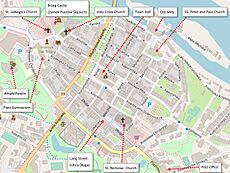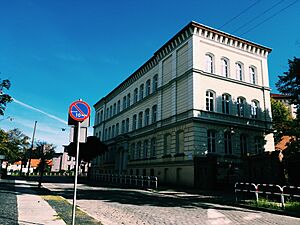Brzeg facts for kids
Quick facts for kids
Brzeg
|
|||
|---|---|---|---|
|
|||
|
|||
| Nickname(s):
The Garden Town
Miasto Ogrodów |
|||
| Country | |||
| Voivodeship | Opole | ||
| County | Brzeg | ||
| Gmina | Brzeg (urban gmina) | ||
| Town rights | 1248 | ||
| Area | |||
| • Total | 16.0 km2 (6.2 sq mi) | ||
| Elevation | 150 m (490 ft) | ||
| Population
(31 December 2021)
|
|||
| • Total | 34,778 | ||
| • Density | 2,174/km2 (5,630/sq mi) | ||
| Demonym(s) | Brzeżan | ||
| Time zone | UTC+1 (CET) | ||
| • Summer (DST) | UTC+2 (CEST) | ||
| Postal code |
49-300
|
||
| Vehicle registration | OB | ||
| National roads | |||
| Website | https://brzeg.pl | ||
Brzeg (pronounced b-zheg) is a town in southwestern Poland. About 34,778 people lived there in December 2021. It is the main town of Brzeg County. Brzeg is located in a region called Silesia, in the Opole Voivodeship. It sits on the left bank of the Oder river.
The town of Brzeg was first mentioned in 1234. Back then, it was a small place for trading and fishing in Piast-ruled Poland. In 1248, a duke named Henry III the White gave Brzeg special town rights. By the late 1200s, the city had strong walls for protection. Brzeg is sometimes called "the garden town" because it grew a lot with new houses built on its edges. From the early 1300s to the late 1600s, the town was ruled by the Piast family. They were part of the Holy Roman Empire. Later, after the Silesian Wars, Brzeg became part of Prussia. From 1871 to 1945, it was part of Germany. After World War II, Brzeg became part of Poland again.
Contents
What Does the Name Brzeg Mean?
In old documents, Brzeg was called Civitas Altae Ripae. This means 'city on the high banks' of the Oder River. Its name comes from the Polish word brzeg, which means 'shore'.
A person from Brzeg is called a brzeżan.
Brzeg's Long History
Ancient Times in Brzeg
People have lived in and around Brzeg since the Mesolithic era, which was between 8000 and 4200 BC. This is known from tools found by archaeologists. The first signs of farming appeared around 4200–1700 BC. People started growing crops and raising animals. This led them to settle down instead of moving around. During this time, people also began weaving, making pottery, and mining in the Brzeg area.
Later, from 1300–700 BC, the Lusatian culture lived here. They continued farming and raising animals. They also worked with metals. Archaeologists found 17 places where they lived, including villages and burial sites.
Around 400–300 BC, the Celts arrived in Silesia. They traded with the Roman Empire around 100 BC. This is known because Roman coins were found here. In the 600s AD, Slavic peoples started settling in the region.
Brzeg in the Early Middle Ages
Between AD 500 and 1000, a system called feudalism began in Silesia. This time saw the growth of towns and trade. It is thought that Silesian tribes settled the area around Brzeg. An old document from the mid-800s mentions the Silesian fort of Ryczyn. This fort was important for defending trade routes along the Oder river.
From the 800s to the early 900s, Brzeg and Silesia were part of Great Moravia. After that, they were ruled by the Přemyslid dynasty until 990.
Brzeg in Medieval Poland
Around 990, Mieszko I brought Silesia into Poland. Later, during a time when Poland was divided, the Brzeg area was controlled by Władysław II the Exile.
Before Brzeg became a town, there were three smaller settlements. "Wysoki Brzeg" was the most important. In 1235, Henry the Bearded took control of the area. Farmers had to give grain to Brzeg, which shows there was a storage building there.
There was also an old church called St. Mary's Church. It was later taken apart, and its bricks were used to build town walls. Near the town, there was a hospital for sick people and travelers. A big market was also held there, where people sold food and other goods. Even before it officially became a town in 1248 or 1250, Brzeg was already like a small city.
The town officially received its German town law in 1250 from Duke Henry III the White. The town was built up by three people: Gerkinus, Ortlif, and Heinrich. Heinrich's family symbol became the town's coat of arms. The town was fortified with walls in 1297.
From 1311 to 1675, Brzeg was the capital of a duchy (a small state) called the Duchy of Brzeg. It was ruled by a local branch of the Polish Piast dynasty. One of these dukes built a castle in 1341. The duchy became part of the Kingdom of Bohemia in 1329. The town was burned by the Hussites in 1428 but was soon rebuilt.
Brzeg in Early Modern Times

In the early 1500s, Brzeg had two schools. In 1529, Duke Frederick II of Legnica tried to make Brzeg a big learning center. He combined the two schools, but they split again in 1534.
The town grew even more under Duke George II. He was friends with the Polish nobility. He rebuilt the Ducal Castle in a beautiful Renaissance style. He also built the Renaissance town hall and a new school called a gymnasium in 1569. This school became popular with Polish noble children.
In 1595, Brzeg's defenses were strengthened again. During the Thirty Years' War, the town suffered a lot. In the War of the Austrian Succession, Prussian forces attacked it. In 1807, Napoleon's army captured Brzeg. When Bohemia became part of Austria in 1526, Brzeg was still ruled by the Silesian Piasts. But when the last duke died in 1675, the Habsburgs took direct control.
Brzeg in Recent History
In 1537, Duke Frederick II of Legnica made a deal with the ruler of Brandenburg. This deal said that Brandenburg would inherit the duchy if the Silesian Piasts died out. However, when the last duke died in 1675, Austria did not agree to this. Frederick the Great of Prussia used this old deal to claim Silesia in 1740. Brzeg and most of Silesia became part of Prussia in 1741. In 1807, Napoleon's army tore down the town's walls. When Germany united in 1871, Brzeg became part of the German Empire. Even under Austrian, Prussian, and German rule, Brzeg was an important place for Polish printing.
During World War II, German forces used two prisons and four forced labor camps in and near Brzeg. In early 1945, some prisoners were forced to march to Kłodzko. The war destroyed 60% of Brzeg. Many people died during the harsh winter of 1944–45 as they fled from the advancing Red Army. The war caused the most damage to the town in its entire history. Some of the German population was moved west for safety. After the Soviets captured the town, the remaining German people were later moved out. Brzeg then became part of Poland again, under its historic Polish name. Poles who had been forced to leave their homes in eastern Poland by the Soviets moved to Brzeg.
Brzeg as a Garrison Town
From the late 1800s, Brzeg grew into a military town. From 1897 to 1919, it was home to the 157th Infantry Regiment of the Royal Prussian Army. In 1914, this regiment went to fight on the Western Front in World War I.
After World War I, the military barracks in Brzeg were empty for a few years. An airfield nearby was also taken apart. On August 4, 1930, the 5th Squadron of Cavalry Regiment No. 8 of the German Reichswehr arrived in Brzeg. This meant changes were needed to the barracks to fit the horses and soldiers. A German cavalry captain from Brzeg, Konrad Freiherr von Wangenheim, won a gold medal in the 1936 Summer Olympics in Berlin, even with a broken collarbone! In 1933, a larger military airfield was built near Brzeg.
Near the end of World War II, on February 6, 1945, the Soviet army captured Brzeg. This caused a lot of damage to the town. After Germany lost the war, Brzeg became part of Poland. Since 1950, the rebuilt town has been part of the Opole Voivodeship.
Where is Brzeg Located?
Town Size and Shape
The town of Brzeg, including its nearby areas, looks like a stretched-out rectangle. It is about 3.54 km long from north to south and 4.10 km wide from west to east. The total area of the town is about 16 square kilometers. This includes the village of Rataje, which joined Brzeg in 1973. Brzeg is the fourth largest town in the Opole Voivodeship by both population and area.
Brzeg's Landscape

Brzeg is the main town of Brzeg County. It is located in the west of the Opole Voivodeship in southeastern Poland. The town is in the valley of the Oder river. It is about 38.5 km east of Opole and 40.7 km northwest of Wrocław. The land in Brzeg is mostly flat. When the Oder river is low, small islands appear north of Jerzynowa, Kępa, and Srebrna Islands. Brzeg is in the Brzeg Plain, which is part of the Silesian Lowlands.
The Brzeg Plain was formed by a large ice age long ago. This left behind small hills. Small streams flow from these hills into the Oder river.
Farming and Trade in Brzeg
Brzeg is in a region called Lower Silesia. This area was settled because of its fertile soil, which was great for early farming. The area was first settled by Silesian tribes. Later, until 1675, it was ruled by the Piast dukes. Today, farming is still a main source of income in the region. There are not many forests, except for the Stobrawa Landscape Park and the Oder river. The forest, farming, and the Oder river (for transport) helped Brzeg become an important trading center in Silesia.
Brzeg's location between two trade routes helped it grow. One route went from west to east (from Legnica to Opole). The other went from north to south (from Gniezno to Nysa and into Bohemia). Today, Brzeg is located near major European roads, the European route E67 and E40.
Brzeg's Green Spaces
Brzeg has five public parks. Three of them surround the Old Town. These parks were created after the town's old walls were taken down in 1807 during the Napoleonic Wars. This area is known as the Planty.
- The Central Park of J. Czajkowski is 6.1 hectares in size. It has an artificial lake and a stream.
- The Park by the Moat (Park nad Fosą) is 3.7 hectares. It is located south of the Silesian Piasts' Castle.
- The Odranian Park (Park Nadodrzański) is the largest park around the Old Town, at 10.9 hectares. The castle and the old Odrzańska Gate are in this park.
The largest park in Brzeg is the Park of Juliusz Peppel. It is 68.8 hectares and is in the southwest of the town. The smallest park is the Park Ptasi, which is 1 hectare.
Who Lives in Brzeg?
Population History
Since the Early Middle Ages, Polish tribes lived in this area. Later, Germans settled here, and policies tried to make the Polish people more German. In 1905, a German census showed that 93% of people in Brzeg spoke German, 6% spoke Polish, and 1% spoke both.
After World War II, Brzeg became part of Poland again. Many Germans who lived there were moved out. Poles who had been forced to leave their homes in eastern Poland by the Soviets moved to Brzeg. Most of these new residents were farmers. By 1975, about 37.9% of Brzeg's population had moved there after 1960.
Where People Came From in Brzeg in 1950:
| Population origin | Number of People | Percentage (%) |
|---|---|---|
| Total population | 12,771 | 100.0 |
| People already living there | 824 | 6.5 |
| People who moved there | 11,947 | 93.5 |
Where Migrant People Came From in Brzeg in 1950:
| Population origin | Number of People | Percentage (%) |
|---|---|---|
| Warsaw | 469 | 3.9 |
| Warsaw Voivodeship | 365 | 3.0 |
| Bydgoszcz Voivodeship | 289 | 2.4 |
| Poznań Voivodeship | 533 | 4.5 |
| Łódź | 75 | 0.6 |
| Łódź Voivodeship | 529 | 4.4 |
| Kielce Voivodeship | 749 | 6.3 |
| Lublin Voivodeship | 387 | 3.2 |
| Białystok Voivodeship | 144 | 1.2 |
| Katowice Voivodeship | 747 | 6.3 |
| Kraków Voivodeship | 911 | 7.6 |
| Soviet Union | 5,144 | 43.1 |
| Other countries | 200 | 1.7 |
| Remaining | 1,405 | 11.8 |
How Brzeg's Population Has Changed:
| Year | Population | Year | Population |
|---|---|---|---|
| 2002 | 38 841 |
2003 | 38 781 |
| 2004 | 38 550 |
2005 | 38 379 |
| 2006 | 38 163 |
2007 | 37 842 |
| 2008 | 37 625 |
2009 | 37 609 |
| 2010 | 37 346 |
2011 | 37 329 |
| 2012 | 37 261 |
2013 | 36 980 |
| 2014 | 36 675 |
2015 | 36 469 |
| 2016 | 36 381 |
2017 | 36 110 |
| 2018 | 35 930 |
2019 | 35 709 |
| 2020 | 35 226 |
2021 | 34 778 |
Cool Places to See in Brzeg
Brzeg has many interesting historical buildings and places:
- The Brzeg Town Hall (Rynek) is a beautiful Renaissance building. It is surrounded by old townhouses from the 1200s.
- The Old Castle (Zamek) has a very interesting decorated front. It houses the Muzeum Piastów Śląskich (Museum of Silesian Piasts). People sometimes call it the Silesian Wawel, like the famous castle in Kraków.
- St. Nicholas's Church is built in the Gothic style.
- Holy Cross Church (on the old castle square) is a Baroque style church.
- St. Jadwiga's Church is located near the castle.
- St. Luke's Church is built in the Neoclassical style.
- Saints Peter and Paul Church is a Franciscan church from the 1200s.
- Christ's Resurrection Church is a military church built in the Baroque style.
- You can see Baroque statues of John of Nepomuk and Jude the Apostle from 1722 near the Holy Cross Church.
- A statue of the Holy Trinity was put up in 1731 on the old castle square.
- The Piast Gimnasium (Gimnazium Piastowskie) was founded in 1569.
- The Odrzańska Gate is a part of the old town walls. It is located in the Odranian Park.
- The Water tower (Wieża ciśnień) on Rybacka Street was built in 1877.
- There are also many old residential townhouses, like:
- Rynek 19, with a Renaissance front from 1621.
- Chopina 1, a Renaissance building from 1597.
- Jabłkowa 5, a Baroque townhouse from 1715.
- Jabłkowa 7, an Empire style building from 1797.
- The Old Garrison buildings (Stare Koszary) are from the time of Frederick the Great.
- The Planty are the remaining parts of the old town's defenses. These were turned into a park in 1807.
- The Synagogue was built in 1799.
- The River Boat Station (Brzeg Marina) was built in 2012 on the east bank of the Oder.
Brzeg's Economy
Industries in Brzeg
Brzeg is an important center for industry in Brzeg County. The town produces agricultural machinery, electric engines, margarine, and sugar.
Many industries are located in the eastern part of Brzeg, south of the Oder river. These include:
- Bartling GmbH, a German company that makes plastic packaging.
- "BESEL", a Polish company that makes electric engines. It was founded in Brzeg in 1950.
- CIK, a factory that makes car accessories.
Brzeg is also home to one of Poland's largest confectionery companies, PWC Odra S.A.. It was founded in 1946 and is now part of the Otmuchów Group.
Tourism in Brzeg
In 2015, Brzeg had the fewest foreign tourists in the Opole Voivodeship. Most visitors were from Poland. Brzeg has fewer places for tourists to stay compared to other regional capitals.
Learning in Brzeg
Brzeg has about 7,826 young people aged 3-24 who could be in school. About 14.4% of people in Brzeg have finished higher education. This is similar to the average for the whole Opole Voivodeship. In 2015, 2.5% of Brzeg's population had completed special post-lyceum (policealne) education. Brzeg has two such schools: a medical one and an economics one.
About 22.4% of Brzeg's population in 2015 had some work-related further education. In the same year, 5.3% of the town's population was in secondary education, and 19.6% were in primary education. The city council spends 33.3% of its yearly budget on education. This is about 35.2 million zlotys each year.
Schools for Older Students:
| Name | Address | Number of Teachers | Number of Students | Website |
|---|---|---|---|---|
| Technikum No. 1 in Brzeg | Słowiańska 18 | – | 466 | – |
| Technikum No. 2 in Brzeg | Jana Pawła II 28 | – | 370 | – |
| I Liceum ogólnokształcące (Bolesław Chrobry) | Armii Krajowej 7 | 31 | 320 | Official Website: http://lo1brzeg.szkolnastrona.pl/ |
| II Liceum ogólnokształcące (Zbigniew Herbert) | 1 Maja 7 | 36 | 341 | Official Website: http://www.wodip.opole.pl/~LO2BRZEG |
| Zasadnicza Szkoła Zawodowa No. 3 (Książę Jerzy II Piast) | Kamienna 3 | – | 261 | Official Website: http://www.zsbbrzeg.pl/ |
| Technikum No. 3 (Książę Jerzy II Piast) | Kamienna 3 | – | 207 | Official Website: http://www.zsbbrzeg.pl/ |
| Państwowa Szkoła Muzyczna Level 1 (Józef Elsner) | Piastowska 18 | 20 | 161 | Official Website: http://www.psmbrzeg.pl/ |
Public Middle Schools (Gymnasium):
| Name | Address | Number of Teachers | Number of Students | Website |
|---|---|---|---|---|
| Gymnasium No. 3 (Orlęta Lwowskie) | Bohaterów Monte Cassino 14 | 35 | 343 | Official Website: http://g3brzeg.wodip.opole.pl |
| Gymnasium No. 2 | Poprzeczna 16 | — | 317 | — |
| Gymnasium No. 1 (Józef Piłsudski) | Oławska 2 | 26 | 225 | Official Website: http://g1brzeg.wodip.opole.pl/ |
| Gymnasium No. 4 | Lompy 1 | — | 142 | — |
Getting Around Brzeg
Brzeg is located where two important roads meet:
- National Road
 goes north to Namysłów and Kępno, and south to Wiązów and Strzelin.
goes north to Namysłów and Kępno, and south to Wiązów and Strzelin. - National Road
 goes west to Oława, Wrocław, and Zgorzelec, and east to Opole, Kraków, and Korczowa.
goes west to Oława, Wrocław, and Zgorzelec, and east to Opole, Kraków, and Korczowa.
The exit to the ![]() A4 Motorway is about 14 km south of Brzeg.
A4 Motorway is about 14 km south of Brzeg.
Brzeg has good train and bus services. The PKP Brzeg railway station has direct connections to many cities like Opole, Wrocław, Kraków, and Warsaw. The local bus service, PKS Brzeg, has ten bus lines around the town. Important bus routes go to Wrocław, Opole, Grodków, and Nysa.
In 2013, a special landing pad for hospital helicopters was opened on Mossora Street.
Sports in Brzeg
- KS Cukierki Odra Brzeg – a women's basketball team. They finished 8th in the Sharp Torell Basket Liga in the 2003/2004 season.
Famous People from Brzeg
- C. de Bridia (born 1247), a friar who wrote about the Tartars.
- Johann Heermann (1585–1647), a German poet and hymn writer.
- Karl Otfried Müller (1797–1840), a professor who studied ancient Greek.
- Max Friedlaender (1852–1934), a German musician and composer.
- Oskar Moll (1875-1947), a German painter.
- Max Obal (1881–1949), a German actor and film director.
- Kurt Masur (1927–2015), a famous German musician and conductor.
- Adrian Tekliński (born 1989), a Polish bicycle racer.
- Kamil Bednarek (born 1991), a Polish reggae and dancehall musician.
- Bartosz Białek (born 2001), a Polish football player.
Brzeg's Sister Cities
Brzeg is connected with these cities:
 Beroun, Czech Republic
Beroun, Czech Republic Bourg-en-Bresse, France
Bourg-en-Bresse, France Goslar, Germany
Goslar, Germany
Images for kids
See also
 In Spanish: Brzeg para niños
In Spanish: Brzeg para niños





